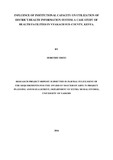| dc.description.abstract | Utilization of Health Information System is becoming a major concern locally and globally. This is based on the need for the management to take proactive leadership in data demand and utilization. The system is also vital in decision making process, detecting and controlling emerging health issues, monitoring and evaluation and ensuring equity. Low utilization of health information system by healthcare workers in health facilities has been identified as a challenge in many developing countries including Kenya. This problem was also identified in Nyakach sub-county, Kisumu County where the health care workers do not fully utilize information from District Health Information System despite enormous resources that have been provided to help in its implementation. It is based on this argument that the study aims at determining the influence of institutional capacity on utilization of District Health Information System in health facilities in Nyakach sub-county. The specific objectives were, firstly to determine how employee capacity influence utilization of district health information system in health facilities in Nyakach sub-county. Secondly to establish how availability of funds influence utilization of district health information system in health facilities in Nyakach sub-county. Thirdly to assess the extent to which size of health facility influence utilization of district health information system in health facilities in Nyakach sub-county. The study was conducted in Nyakach sub-county, Kisumu County. It adopted descriptive research design where both quantitative and qualitative data were collected using questionnaires from a total of 20 District Health Information System managers and 124 users in public health facilities in Nyakach Sub County. The researcher adopted stratified random sampling to select the respondents since the population was heterogeneous consisting of different cadres of healthcare workers. Quantitative data was analysed using both descriptive and inferential statistics where pearson-product moment correlation were applied to be able to determine the relationship between institutional capacity and utilization of District Health Information System in Nyakach Sub-County. Validity of the research instruments was obtained through piloting and expert evaluation. Reliability was tested using a test retest method. The findings of the study included a negative correlation between employee capacity and utilization of district health information system, with values being significant for users (-0.479) and insignificant for managers (-0.349). There was also a positive and significant correlation between availability of funds and utilization of district health information system, with the values being significant for users (0.415) and insignificant for managers (0.181). In addition, there was a positive and significant correlation between size of health facility and utilization of district health information system for both users and managers at (0.809) and (0.462) respectively. From the study results, it is evident that the limiting factor to the utilization of district health information system in health facilities is employee capacity and availability of funds. Inadequate employee capacity is mainly due to lack of trainings and skills while availability of funds is mainly due to inadequate staff and lack of infrastructures to support and encourage the use of District Health Information System. In view of the above findings, the study recommended capacity building and mentorship for both the users and managers. This is necessary as it will ensure that both managers have the capacity and skills to effectively utilize District Health Information System in their facilities. Secondly, the author recommends that authorities and ministries should employ more staff and avail more funds to the facilities to effectively run District Health Information System. The findings of the study will be significant in contributing to the basis upon which partners and donors such as non-governmental organizations, religious groups and political systems, can better health care delivery. However, further studies should be done on the subject so that the findings in this study can be confirmed and verified by many more studies. | en_US |



